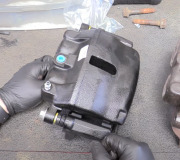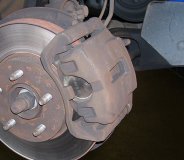Hi guys. There is no such thing as a "stationary" side. If that were true, what would apply pressure to the outer pad? Stationary calipers are only used when there are two or four pistons, and half of them are behind each pad.
What you have is a "floating" caliper that sits on a pair of pins that are bolted to the knuckle. The biggest thing competent do-it-yourselfers overlook is those pins must have absolutely no rust on them or caked grease, and they must be coated with a special high-temperature brake grease.
If those pins have any rust spots or places where the chrome plating has lifted, the rubber isolators will grab onto that during brake application and prevent the caliper from sliding freely. The piston applies pressure to the inner pad, then it pushes the caliper inward to apply equal pressure to the outer pad. You might have to tug a little, but the caliper must slide on those pins with hand pressure. In the worst case, the caliper will be bound tight by rust. A lot of people just hang new pads on the vehicle, but professionals will want to replace those rubber inserts, and often the pins too, to insure a quality repair.
The brake grease is used on those pins, and on the contact points where the piston and the caliper's fingers contact the pads' backing plates. A flat file should be used on those points first to insure no rust or dirt is on there that would prevent the pads from sitting squarely. The pads ARE going to vibrate, and that grease will allow them to do that without transferring the noise to the calipers where it would get amplified and heard as a squeal. When filing those surfaces, you don't have to shine them up. All you're after is to remove any debris that would get caught between the pads and the caliper's fingers and piston.
Brake grease is designed to not migrate like regular axle grease would, and it won't smoke at the normal 400 degrees brakes can get to. "Rusty Lube" is one trade name I'm familiar with, but there are others. The products all contain molybdenum disulfide.
If you had the rotors machined, it will be easier to install the new pads. I've had a bunch of cars that I thought had the wrong pads because I had a hard time squeezing them in, but I always got them in eventually. It can be harder with new rotors because they're thicker. Look at the pistons too to be sure they're fully retracted. You should never have to resort to using a c-clamp to retract a piston. If you do, there's a ring of crud or corrosion built up around the piston that is being forced under the rubber square-cut seal. Even if you were able to strong-arm the piston in that way, it is going to stick and not apply under light brake pedal pressure, and it will not release after hard braking. We used to rebuild calipers all the time for that, but today we don't have much trouble in that regard, and rebuilt calipers are so inexpensive that it doesn't pay to buy the rebuild kits and go through all the work. I use a large flat blade screwdriver to pry the pistons into the calipers before I unbolt them, then that part of the job is already done when I stuff the new pads in. I have seen people have the calipers off already, then figure out they have to retract the pistons, and they resorted to a c-clamp just because it takes less effort, but doing so can mask a sticking piston to the point you don't recognize it and catch it. If you DO use a clamp, it should not take excessive force. If you are breaking a sweat trying to retract a piston, you have other problems that must be addressed. A strong person can retract a piston by hand pressure.
Sunday, June 26th, 2016 AT 11:30 PM



